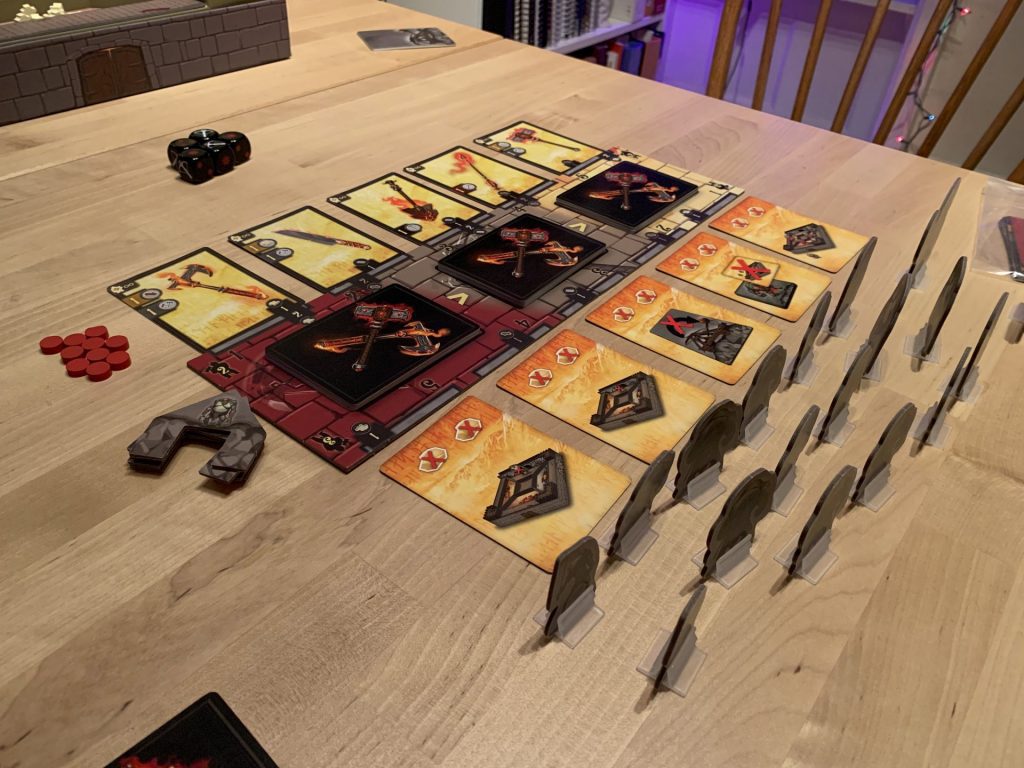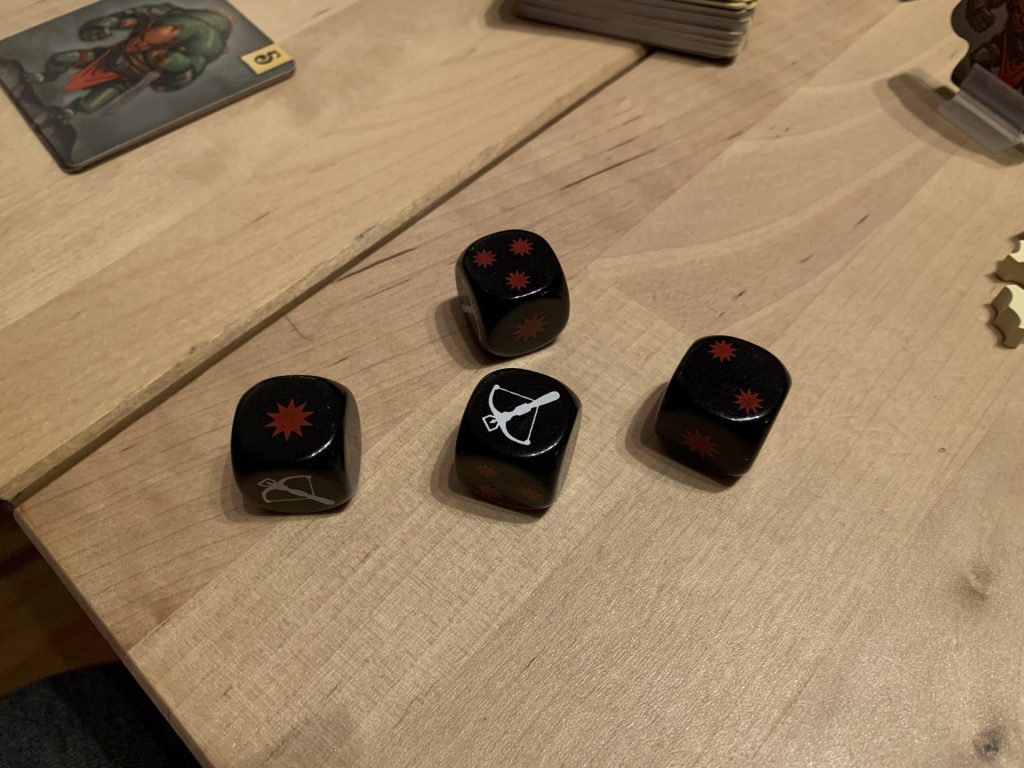The dwarven fortress of Runedar is under siege by an army of orcs and trolls. You, the last survivors, have no hope of victory. In this, your darkest hour, you must work together to keep the attacking army at bay long enough to dig an escape tunnel, forging improved tools and weapons all the while. Can you escape in time or will you perish in the ruins?
Now that is a premise. I’d watch that movie, let alone play that game. From the moment publisher Ludonova announced The Siege of Runedar, I was excited. A game with a great theme is always cause for celebration in my house, as is a deck builder, as is a big design from Reiner Knizia. The fact that Siege marks Knizia’s first major contribution to collaborative board gaming since 2000’s The Lord of the Rings—I’m sure Whoowasit? stans exist, but let’s be reasonable—was icing on the cake.
In The Siege of Runedar, players draw from a personal deck, using their tools and weapons to perform various actions, including Move, Attack, Dig, and Work Resources. Attack deals with Orcs, Trolls, their siege weapons, and the occasional Goblin, Dig clears rubble from the tunnel that will eventually lead to your freedom, and Work Resources gives you access to more advanced cards on the Upgrade Board. In a novel bit of design, any player is free to take a card once it is forged, even if they didn’t work on it themselves. Players work together to get everyone’s decks upgraded, a truly collaborative deck build.
The first play was wondrous. The thematic integrity of the mechanics—it is one of the more beautifully thematic marriages of mechanic and story that I’ve ever seen—allowed the game to melt away, disappearing into the story of these four dwarves desperately fighting to hold on. The action built to a frantic crescendo; about halfway through, every turn felt like you had 10 fires to put out and only one bucket of water. We cheered and laughed as our dwarves ran from room to room, working materials and battling orcs.
One member of the playgroup didn’t like it. “The game is repetitive and takes too long,” she said. “No, you’re being finicky,” we told her, “You’re wrong. This was so fun!”
The Game Is Repetitive and Takes Too Long
During repeated plays of Siege, my enthusiasm waned and I found myself thinking of Dice Forge, an initially charming game that quickly became tedious. Repetition, of course, is a part of any game. A great game doesn’t ask you to do a million different things, it asks you to do three or four at the most while making them feel like a million different things.
I find games start to feel repetitive, which can be and in this case is distinct from boring, when I am performing the same physical action over and over again. In Dice Forge, you roll your dice and move your resource markers on every. player’s. turn. Siege of Runedar’s ceaseless back and forth of worked resources from the castle to the cards, from the cards to the castle, quickly grew tiresome. The feeling compounds as the game accelerates towards the end because the cost of the cards increases right alongside your ability to produce.

Gathering and spending materials is common in games, and I seldom have this issue. The problem here is the rapidity and frequency with which it occurs. If you play the game well, there’s a constant churn of materials going out to the cards and coming back to the castle. Counting out six leather for one card only to put it back on the next player’s turn isn’t fun. Even if you do an immediate turnaround of your resources in most competitive games, it happens on your next turn, so there will have been a somewhat lengthy round in between. In this, the brisk cooperative pace of Siege works against it. Things are not helped by the fact that the burden of moving the material is likely to fall disproportionately on an individual player due to Siege of Runedar’s production choices, which hurt just as much as they help.

The board, a 3D fortress sticking out of the bottom half of the box, is striking, and gives the game a wonderful toy factor. My first play, I felt like a fierce li’l dwarf running from rampart to rampart, and the board is a huge part of that. There are real downsides, though, beginning right away with setup. Unless you have just the right kind of round table, you’re going to struggle with getting everyone in a good position. We settled on placing the board down the table from everyone, but the dwarven standees became difficult to differentiate, thanks to similar silhouettes and muted color palettes, and the ridges separating the five rooms in the center of the board made it difficult to see how much gold—hit points—and rubble—the thing you have to get rid of to win the game—was left.
The repetition and minor annoyances are compounded by the playtime. After five plays with the same pool of people, we have yet to bring The Siege of Runedar in at under 90 minutes. Even the first game felt long, though at the time we were inclined to put the blame on our inexperience.
The Situation’s a Lot More Nuanced Than That
There is unquestionably brilliance here. It’s just obscured. My favorite moment playing The Siege of Runedar was when Frank set his sights on the catapult, one of the Orc army’s two powerful siege weapons. He bounded up the steps to the nearest tower, the maximum range attack in his hand. “I climb the wall to the tower,” he said, “and rain arrows down on them,” miming the draw and release of a bow as he did so. Frank rolled five dice, each of which had a 33% chance of rolling a ranged hit. He only needed one. All five came up empty.

Siege of Runedar shines as a machine for stories rather than as a series of strategic choices and systems. This is primarily because the combat is entirely dependent on dice, save for one (1) card, and you have no means of mitigating the results of a roll. That will tell you a lot about whether or not it’s something you’ll want to try. The choices you make are fairly low-stakes from decision to decision. Divorced of the theme, the mechanics wouldn’t be particularly remarkable, though this is a bit like saying “chocolate is only good because of the flavor.” I’ve come to the conclusion that the game was made that way on purpose. If Frank’s roll felt like the payoff to a game’s worth of intense strategic choices and scrupulous planning, I would have been furious. As it is, I’m still laughing months later. Failure is infuriating in a game, but hilarious in a story.
Only Love Can Break Your Heart
The Siege of Runedar goes on for too long, it’s repetitive, and every game feels about the same. The production choices work against it just as much as they work in its favor. Looking over a PDF of the rules as I finish this review some 800 miles from my copy in New York City, I find myself thinking, “But…it’s good, right? Like, if we played it again, it would click this time for sure.” It’s that kind of game for me. I want to love it, but during my last two plays, I found myself thinking the most dangerous thought of all: “We could be playing [insert game here] right now instead.”
At a tight and tense 45 minutes and with a less fiddly upgrade system, The Siege of Runedar would be a masterpiece of storytelling, and a shoe-in for one of my favorite games. The best parts come in the back half, as dwarves tear about the keep, ripping through orcs and forging powerful weapons, the players screaming at the dice and each other. That’s what I want the whole game to be. Throw us straight into the fire. That’s where the greatest moments are forged.












Add Comment